Self-loading rifle Remington Autoloading Rifle / Model 8 (USA)
Like many other models of small arms of the time, which were notable for their novelty and originality of design, the Remington Autoloading Rifle rifle (Remington Self-loading Rifle) was developed by designer John Moses Browning. At the turn of the XIX and XX centuries, this gunsmith developed several versions of self-loading systems. In 1900, the J.M. Browning received a patent for the number US 659786 A on a new design of a self-loading rifle based on automation with a long barrel stroke. A little earlier, similar automation was used to create a gun that went into a series called Browning Auto-5. Now this system was proposed to be used in weapons of a different class.

General view of the Remington Model 8 rifle. Photo Thegreatmodel8.remingtonsociety.com
The project of a new rifle shortly after receiving the patent was sold to Remington. Previously, this organization showed no interest in a self-loading rifle, but wished to launch the production of rifled hunting weapons with automatics. For various reasons, the production of the new model was not established immediately. The new series rifles, called the Remington Autoloading Rifle type, entered the market only in the 1906 year - about a year after the direct analogue in the form of the Model 1905 from Winchester. However, thanks to some features, the Remington rifles were able to compete with the existing model.
It should be noted that the name Remington Autoloading Rifle was used only for the first few years. The latest products with this designation were released in the 1911 year, after which rifles became known as Model 8. The name change did not lead to any major design changes. Rifles of different lots and different years of release could differ only in terms of manufacturing techniques, finishes, etc.
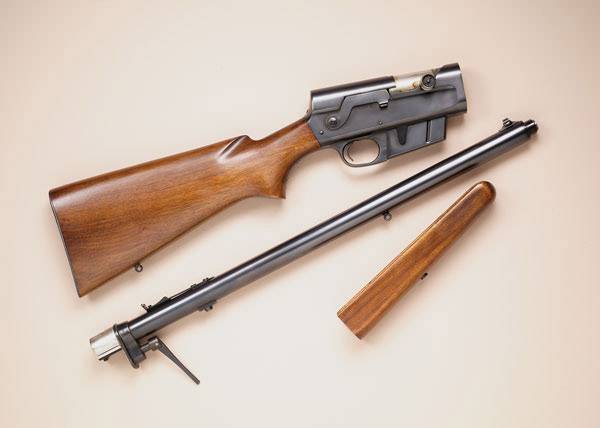
Disassembled weapons. Photo Guns.com
The new rifle was originally designed to use several types of ammunition. With a small interval, modifications for Remington self-designed ammunition from .25 to .35 were created and put on the market. So, the .25 Remington cartridge (6,54x52 mm, bullet weighing 7 or 8 g) with the 22-inch barrel gave an initial speed of up to 710 m / s at energy up to 1740 J. The most powerful cartridge of the .35 Remington (9,1х48,8 mm) got or 12 g. The maximum initial speed of the bullet reached 13 m / s, muzzle energy - to 680 J. Such parameters allowed the use of new weapons in the hunt for various game, including the large beast.
At the heart of the project Remington Autoloading Rifle / Model 8 lay the groundwork for the previous self-loading smooth-bore gun, designed by J.M. Browning The original design was modified to change the size and configuration of individual parts, using other springs, etc. In addition, for obvious reasons, it was decided to abandon the existing tubular grenade shop in favor of more suitable devices for the rifle. The result was the emergence of a system that is externally similar to other similar samples from a given time.
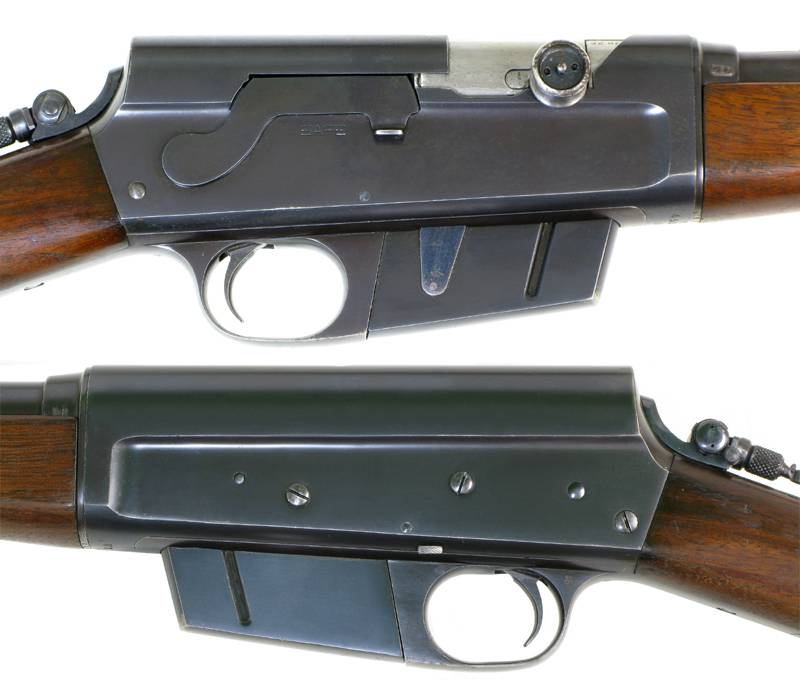
Receiver box and store close-up. Photo Thegreatmodel8.remingtonsociety.com
In his new project J.M. Browning decided to use some of the original layout solutions, which largely contributed to the main features of the new model. So, it was decided to place the return and buffer springs of the trunk directly on it, and also to cover them with a cylindrical casing. Thus, the movable barrel of a relatively small external diameter had to be placed inside the casing, which slightly changed the general outline of the weapon. Inside the barrel casing, near its central part, there was an annular thickening that served as a stop for the buffer spring. The spring was placed in front of the stop, and its front end interacted directly with the second spring. That, in turn, was in contact with the muzzle of the barrel.
Regardless of the type of cartridge, all modifications were equipped with a barrel length of 22 inch (560 mm). Thus, the barrel length in calibers depended on a specific modification and varied from 63 to 88. Consequently, the main firing characteristics of weapons of different versions should have been different.
The movable barrel and its casing should have been connected to the corresponding openings and fixings of the receiver. It was proposed to place all the main parts of the weapon inside the receiver of a complex shape. The box was a part with a tubular upper part, which was a channel for the shutter, and a rectangular lower part, in which other necessary parts were placed. Also, from the back of the receiver a long tube was removed, which was placed inside the butt. It contained its own return spring shutter. The bottom cover of the receiver could be removed from its place. It had a window for installing the store, as well as a hole for the trigger, covered with a safety bracket.
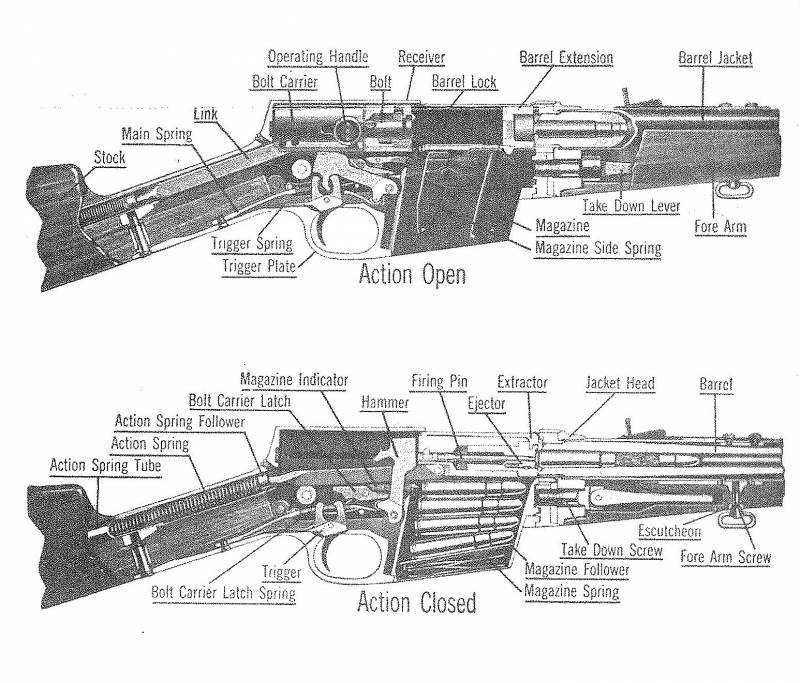
Scheme of work automation. Above - the bolt is retracted to the rear position, below - the weapon before the shot. Picture from user manual
The connection of the receiver and the receiver group was made using several grooves and screws. On the back of the barrel casing there was a base plate with a set of holes, which was installed on the front of the receiver, after which it was necessary to screw a screw into the hole under the barrel. For the convenience of working without the use of tools, the screw received a hinge handle. With it, it was possible to both unscrew the screw, taking apart the weapon, and screw it back. The lever handle of the mounting screw was placed in the corresponding cavity inside the forend.
The rifle bolt was designed as a part, the outer surface of which was close to the cylinder. Inside the gate was placed a movable spring-loaded drummer. The front part of the bolt was equipped with lugs for coupling with the rear sleeve of the barrel. To the rear part of the gate, the pusher, which was in contact with the return spring, was hinged and, during the operation of the automation, could enter the tail tube of the gate. On the right side of the bolt there was a handle for cocking the weapon.
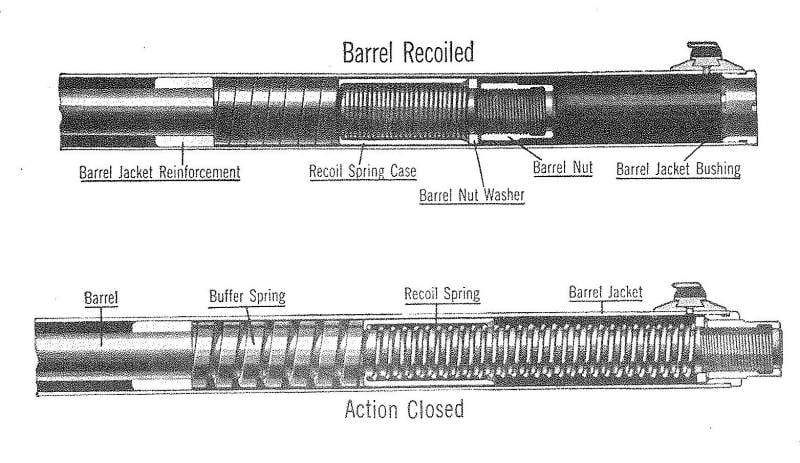
Movement of the barrel during firing: at the top - the trunk during a full recoil, at the bottom - in a neutral position. Picture from user manual
The Model 8 rifle received a fairly simple trigger-type firing mechanism, placed in the rear of the receiver. His main detail was the trigger, made in the form of a swinging lever, driven by the mainspring. The front (relative to the shooter) end of the trigger was flat and interacted with the drummer, the rear - with the projection for contact with other parts. In the cocked position, the trigger was blocked by the U-shaped upper part of the trigger. In this case, the protrusion of the trigger was placed between the teeth of the hook. The trigger got its own spring.
On the right side of the receiver was located a curved fuse box. In the upper position, he blocked the work of USM, and also did not allow the shutter to move, not allowing its handle to move. With the flag down the weapon could fire.
In the basic configuration, the new rifle J.M. Browning was equipped with an integral box magazine with a capacity of four or five rounds, depending on the type and size of ammunition. Directly in front of the trigger guard was the body of the store, in which, with the help of a clip or manually one by one, cartridges should be placed through the window for ejection of cartridges. The store could be removed from its place only during the maintenance of weapons with disassembly into separate parts.
The rifle was supposed to receive wooden fittings. Under the barrel was placed the forearm of medium length, which allowed to protect the barrel cover from external influences, and the shooter’s hands from elevated temperatures. Also inside the forearm was the lever of the fastening screw. Behind the receiver was attached a wooden butt with a thin neck. Late modifications could get a pistol projection butt. In the upper part of the neck of the butt provided a groove for installing the casing of the return spring of the shutter. In addition, for the correct interaction of parts of this groove was further deepened. On the fore-end and the butt were placed anabs for a belt. Antabka forearm, in order to simplify the design of the weapon, was on the screw that fastened the wooden part.
Sights rifle Remington Autoloading Rifle were standard for weapons of the time. At the muzzle of the barrel there was an adjustable front sight, above the breech - an open sight with the possibility of setting a range of fire.
The rifle Model 8 in the combat position had a length of 1055 mm. When disassembling for transportation, the largest part turned out to be a barrel group having a length of 584 mm. Rifle assembly, but without ammunition weighed about 3,5 kg.
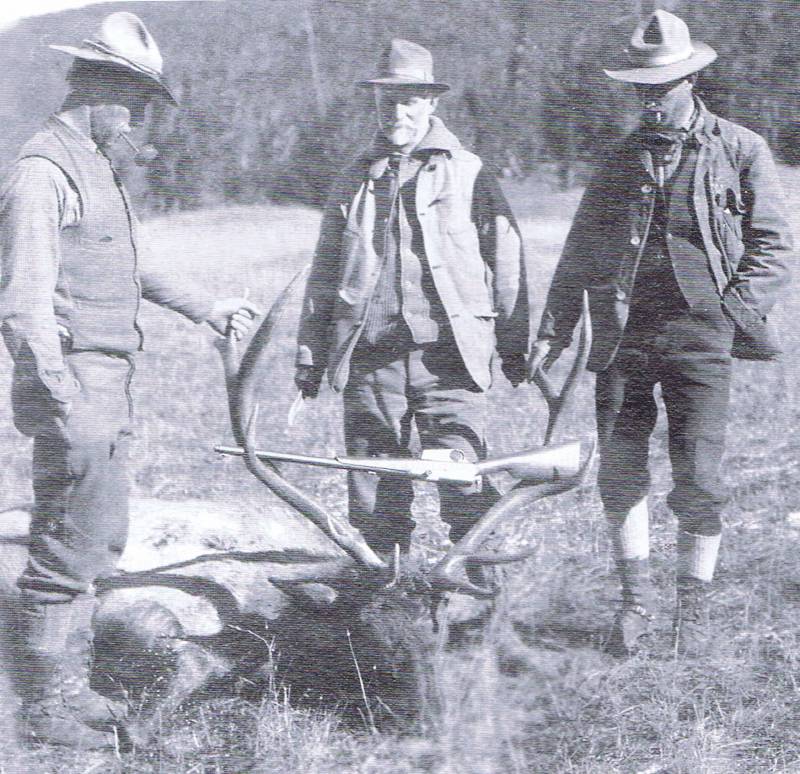
John Moses Browning (center) and his comrades with a trophy captured with a Remington Model 8 rifle. Photo Thegreatmodel8.remingtonsociety.com
Preparing a rifle for shooting was quite simple. With or without a clip, it was necessary to equip the magazine, after which the fuse box moved down and the weapon could be cocked with the bolt handle. Upon the return of the handle to the forward position, the rifle was ready to fire.
When you press the trigger release of the trigger occurred, followed by its interaction with the drummer. Under the impact of recoil shot barrel coupled with the shutter, began to roll back, compressing the two return and buffer spring. Having passed a predetermined distance, the shutter, interacting with the guides of the receiver, unlocked the barrel and continued to move on. The barrel, in turn, braked and returned to the neutral position. With multidirectional movement of parts, the sleeve was removed and ejected.
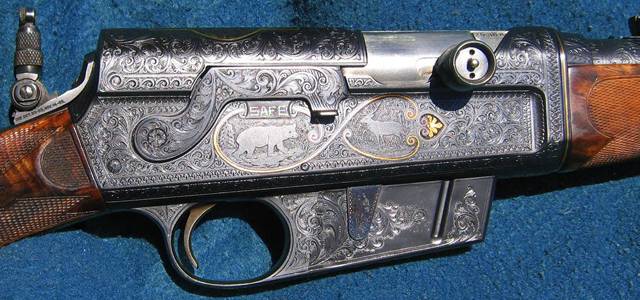
Rifle with finish class "F". Photo Thegreatmodel8.remingtonsociety.com
Moving back, the shutter pulled the trigger and threw it back and down, where he was engaged with the trigger. With the passage of the rear part of the trajectory of the trajectory, the pusher fixed pivotally went beyond the bounds of the receiver and fell into the tube of the return spring, squeezing it. In the rearmost position, the bolt reached the rear wall of the receiver, and the return spring was as compressed as possible. Then she straightened and pushed the bolt, forcing him to go forward, grab and send a new cartridge, as well as lock the barrel. After returning the bolt to the frontmost position, the rifle was ready for a new shot.
In 1906, the first version of the Remington Autoloading Rifle rifle for .35 Remington ammunition with a four-cartridge magazine appeared in stores. The following year, a rifle chambered for the .30 Remington cartridge was introduced, after which modifications with 0,32 and 0,25 inch caliber shafts appeared. Thanks to these cartridges, the rifle was distinguished by sufficiently high firepower, which could not fail to attract shooters-hunters. The manufacturer did not hesitate to use the power of a rifle for promotional purposes. For example, on several versions of advertising posters bears and other large animals were depicted as a clear demonstration of the rifle's capabilities. For comparison, self-loading rifles from Winchester could be used for hunting game no larger than a deer.
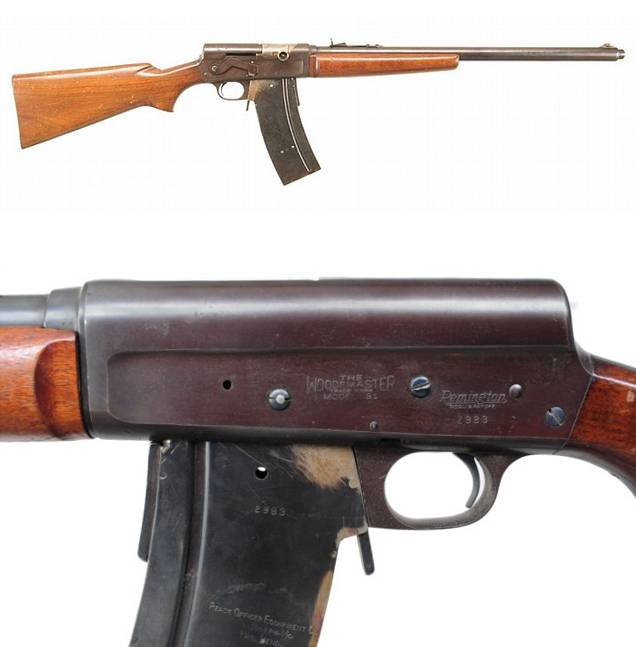
"Police" rifle Model 81. Photo Thegreatmodel8.remingtonsociety.com
The Remington Autoloading Rifle rifle was produced only for five years. In 1911, the weapon was renamed the Remington Model 8, slightly changed the finish and presented as a new model. For several years, the company-manufacturer has produced about 26 thousand rifles of the first version. The updated and slightly improved Model 8 remained in production until 1936. The total release of this weapon was 80600 units.
Over time, the production of several variants of rifles, differing from each other in design, was mastered. The differences were in the decoration of wooden parts and the design of the receiver. For example, the “older” versions received skillful engraving on metal surfaces, while the simplest ones did not even have notches on the accessories. Design options were originally denoted by numbers from one to six. Then they began to be denoted by additional letters from “A” (the simplest) to “F” (the most difficult).
In the mid-thirties, by the design office of the firm Remington, the initial project of J.M. Browning has been improved and updated. The result of this work was the appearance of the Model 81 Woodmaster rifle. Modifications have been mechanics and other units of weapons. In addition, the list of compatible ammunition was changed. Model 81 rifles were supposed to use the .300 Savage cartridge. It was also released a number of products chambered for .25 Remington, but they were soon removed from production. The release of specially designed products with notches, engravings, etc. was kept.
Model 81 rifles remained in production until 1950. During this time, the 55581 unit of such weapons was assembled and sold. Like its predecessor, Woodmaster enjoyed a certain popularity, although it could not match the base rifle of the family.
In 1910, the production of self-loading rifles J.M. Browning was established in Belgium at the factory Fabrique Nationale. Belgian rifles were given the designation FN Browning 1900. Interestingly, the American and Belgian gunsmiths were able to peacefully divide the market and sign the corresponding agreement. So, Remington left the United States market, and FN could sell its rifles to the rest of the world. However, for various reasons, the geographical advantage has not been realized. From 1910 to 1929, Fabrique Nationale only released FN Browning 4913 1900 rifles.
Initially, the Remington Autoloading Rifle rifles were bought only by hunters. Over time, other potential operators have shown their interest in such weapons. In the early thirties, the American police and the FBI began rearmament, aimed at reducing the backlog of criminals in firing capacity. Among other samples, new versions of the Model 8 rifle were ordered. The main difference between police and hunting weapons was the design of the store. In place of the basic design, a receiving shaft was placed, in which a detachable box magazine on 15 cartridges with their single row placement should be placed. The store was held in its place by the front stop and rear latch. There is also information about the release of a certain number of additional increased magazines on 20 cartridges. Part of the rifles were made in a modification of the Ranger, which received the forearm with the front handle.
"Police" rifles were produced by special order in parallel with the main version of the weapon. In the 1936 year, after updating the model range, the Model 8 product came to replace the similar Model 81 with the appropriate modifications. The Remington self-loading rifles were used by security forces for a long time and helped at least partially solve the weapon problem to confront armed criminals.
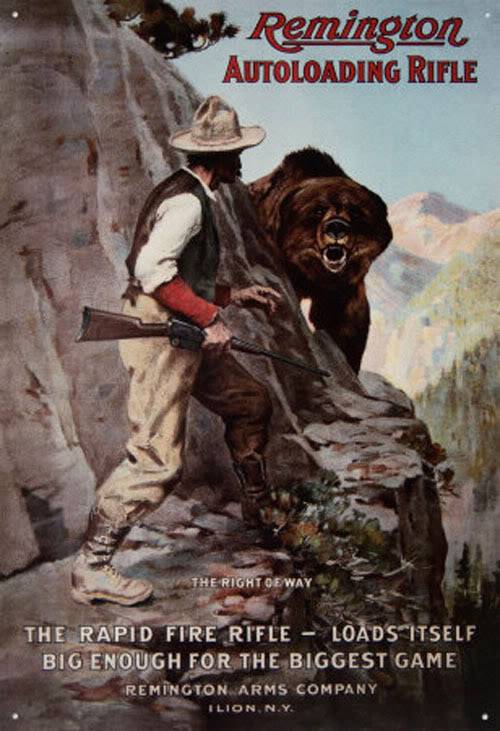
Advertise the Remington Model 8 self-loading rifle. Figure Guns.com
The Remington Autoloading Rifle / Model 8 semi-automatic rifle was not the first member of its class to enter the market, but despite this, it was able to compensate for some time lag behind competitors. The combination of the ability to self-recharge, ease of use and a number of modifications for different cartridges with sufficiently high power did the trick. Remington rifles were much more popular with customers than Winchester’s designs. Thus, from 1905 to 1920, more than 29 thousand Winchester Model 1905 rifles were produced, while in 1906-11, a rival firm sold 26 thousand Remington Autoloading Rifle rifles. In the future, the number of self-loading rifles of two manufacturers became equal, and soon the development systems of J.M. Browning took the lead.
The large number of issued rifles of the Remington Autoloading Rifle / Model 8 / Model 81 family (more than 167 thousand) clearly shows the potential of the project of J.M. Browning, as well as the success of the design he developed. Self-loading rifles of several types were produced in large quantities for almost half a century. Part of this weapon, having shown high reliability characteristics, is still used by shooters. In addition, a significant number of such rifles represents historical value and are exhibits of museums or private collections. This fact can also be another confirmation of the success of the design.
On the materials of the sites:
http://thegreatmodel8.remingtonsociety.com/
http://guns.com/
http://universityofguns.com/
http://remington.com/
https://americanrifleman.org/
US Patent 659786 A:
https://google.com/patents/US659786
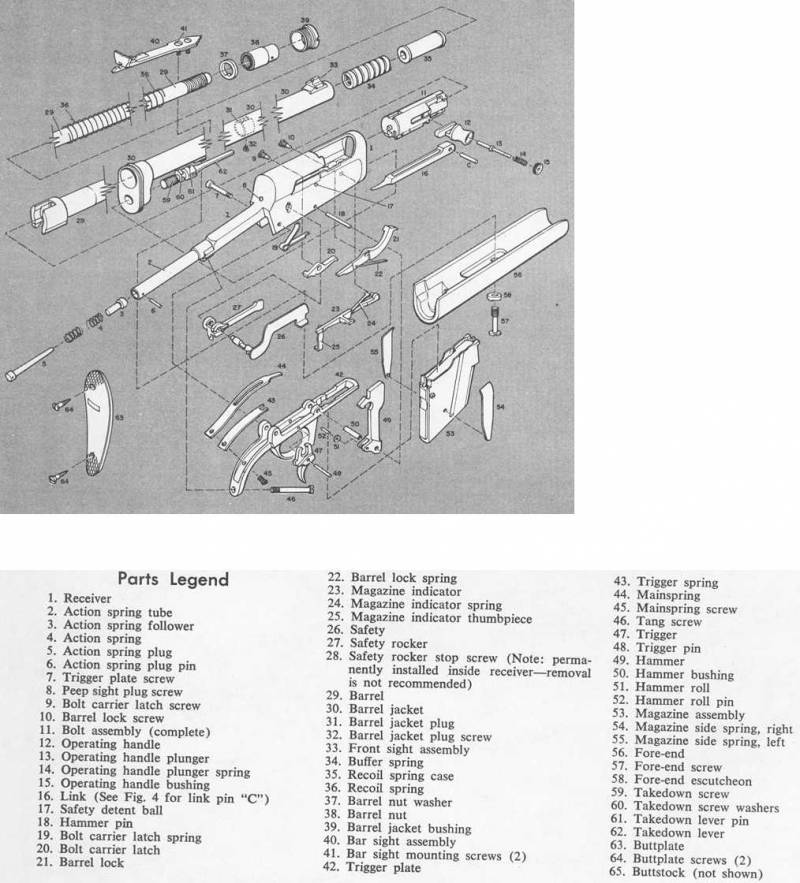
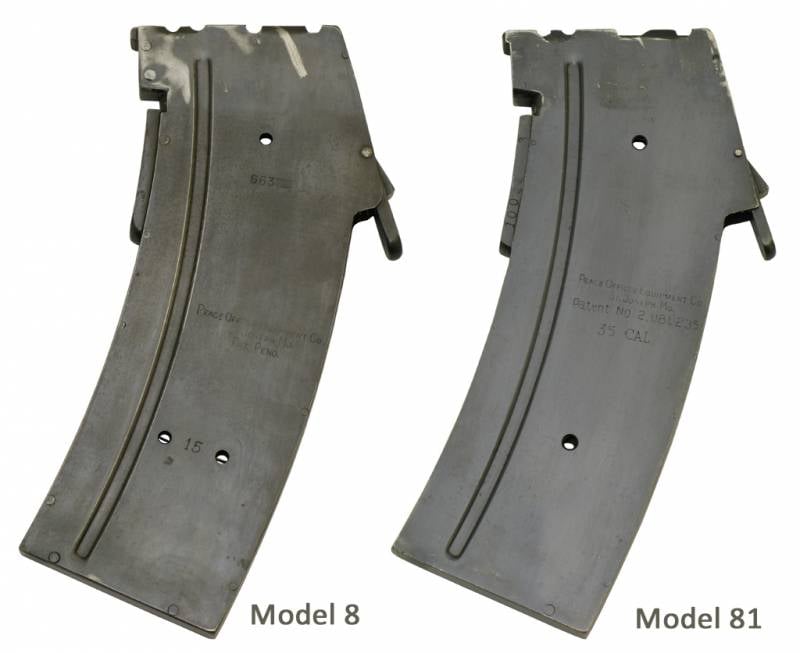
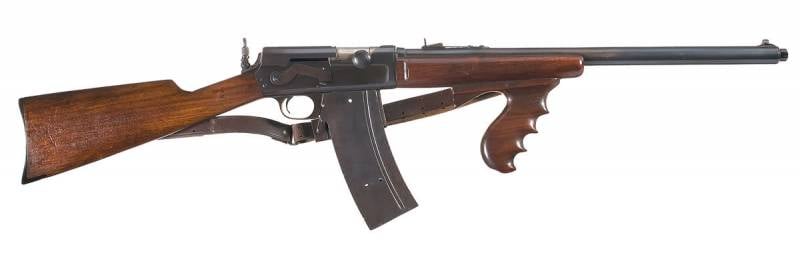
Information